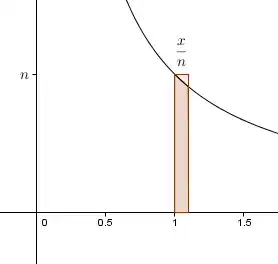This is a rigourous argument, but I think it gets at an intuition.
At the heart of this argument is that $$f(x)=\frac{e^x}{1+x}$$ has the property that $f(0)=1$ and $f'(0)=0$, and therefore that $$\lim_{n\to\infty} f(x/n)^n = 1$$
To get there, we'll use a key fact.
The key fact about this sort of limit is that if $g(n)$ is a function and $\lim_{n\to\infty} ng(n) = 0$, then $$\lim_{n\to\infty}(1+g(n))^n\to 1$$
I'll prove this key result later. It's essentially a nearly trivial result of the binomial theorem.
Now, if $f(0)=1$ and $f'(0)=0$ then $$\lim_{h\to 0}\frac{f(xh)-1}{h} = xf'(0)=0$$.
Letting $h=1/n$, this means that $\lim_{n\to\infty} n(f(x/n)-1) = 0$. Letting $g(n)=f(x/n)-1$, then, the "key fact" shows that $$\lim_{n\to\infty}f(x/n)^n = 1$$
Now, given $f_1,f_2$ two functions differentiable at $0$ with $f_1(0)=f_2(0)\neq 0$ and $f_1'(0)=f_2'(0)$, we can define $f(x)=\frac{f_1(x)}{f_2(x)}$, and see that $f(0)=1$ and $f'(0)=0$. This shows that:
$$\lim_{n\to\infty} \left(\frac{f_1(x/n)}{f_2(x/n)}\right)^n=\lim_{n\to\infty} f(x/n)^n=1$$
Then let $f_1(x)=e^x$ and $f_2(x)=1+x$ to get your limit.
Essentially, the fact that the derivative of $e^z$ at $0$ is $1$ means that $e^z$ is "close enough" to $1+z$ when $z$ is small to allow us to use our "key fact."
Back to proving our "key fact."
Lemma: If $ng(n)\to 0$ as $n\to\infty$, then $\lim_{n\to\infty}(1+g(n))^n=1.$
Proof: We use a binomial theorem argument. When $|ng(n)|<1$ we have:
$$\begin{align}\left|(1+g(n))^n - 1\right| &\leq \sum_{k=1}^n \binom{n}{k}\left|g(n)\right|^k\\
&\leq \sum_{k=1}^n n^k|g(n)|^k \leq \sum_{k=1}^\infty (n|g(n)|)^k\\&=\frac{n|g(n)|}{1-|ng(n)|}
\end{align}$$
So $(1+g(n))^n\to 1$ since $\frac{ng(n)}{1-ng(n)}\to 0$.
The reason I say the above is a "key fact" is that if instead we define $e^x$ as $\lim(1+x/n)^n$, we can then use the "key fact" to show that $e^{x+y}=e^xe^y$, which follows since $$\frac{(1+x/n)(1+y/n)}{1+(x+y)/n} = 1+O(1/n^2)$$
We can also use it to show that $e^{ix}=\cos x+i\sin x$ by having approximations $\cos \frac x n = 1+O(1/n^2)$ and $\sin \frac{x}{n}=\frac{x}{n}+O(1/n^2)$.
We can prove those approximations for $\sin x$ and $\cos x$ essentially geometrically as follows.
We have that $\sqrt{2-2\cos \theta}$ is the length of the chord from $1+0i$ to $\cos \theta+i\sin \theta$, and thus that length is less than the length of the circle arc, $\theta$, so $0\leq 2-2\cos\theta \leq \theta^2$, or $|\cos \theta -1|=O(\theta^2)$.
We can also show geometrically that $x\cos x\leq \sin x \leq x$, so $$0\leq x-\sin x\leq x(1-\cos x)=xO(x^2)=O(x^3)$$
That $\sin x\leq x$ can be seen because $\sin x$ is the shortest distance from $\cos x+i\sin x$ to the real line, while $x$ is the length of the circle arc from the same point to the real line.
The other inequality is a little harder. We can find a path of length $2\tan x$ between $cos 2x + i\sin 2x$ and $1+0i$ that is strictly outside the circle except at the endpoints, thus showing that $2\tan x \geq 2x$ or $\sin x\geq x\cos x$.
With these two approximations for the trigonometric functions, we get, for fixed $x$, $$\cos \frac{x}{n} +i\sin \frac{x}{n} = 1+\frac{ix}{n}+O(1/n^2)$$
